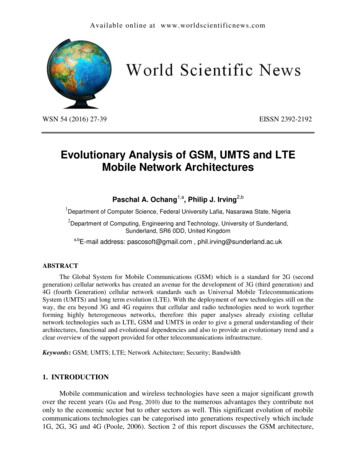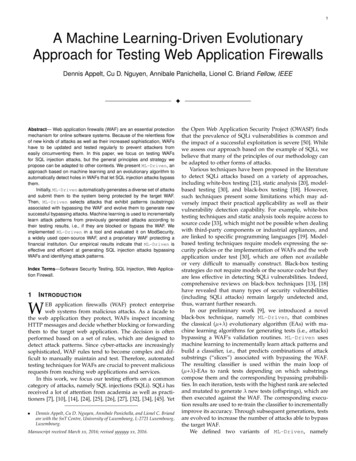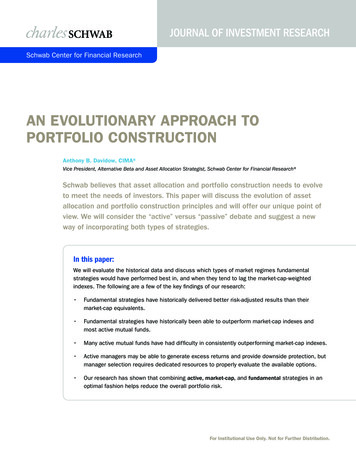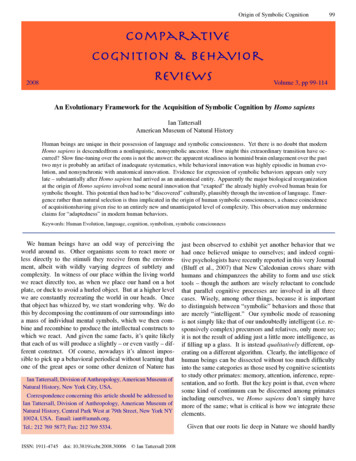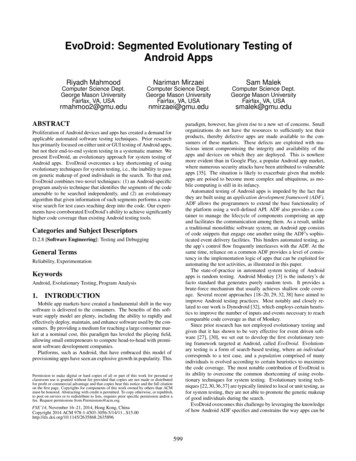
Transcription
EvoDroid: Segmented Evolutionary Testing ofAndroid AppsRiyadh MahmoodNariman MirzaeiSam MalekComputer Science Dept.George Mason UniversityFairfax, VA, USAComputer Science Dept.George Mason UniversityFairfax, VA, USAComputer Science Dept.George Mason UniversityFairfax, VA, m, however, has given rise to a new set of concerns. Smallorganizations do not have the resources to sufficiently test theirproducts, thereby defective apps are made available to the consumers of these markets. These defects are exploited with malicious intent compromising the integrity and availability of theapps and devices on which they are deployed. This is nowheremore evident than in Google Play, a popular Android app market,where numerous security attacks have been attributed to vulnerableapps [35]. The situation is likely to exacerbate given that mobileapps are poised to become more complex and ubiquitous, as mobile computing is still in its infancy.Automated testing of Android apps is impeded by the fact thatthey are built using an application development framework (ADF).ADF allows the programmers to extend the base functionality ofthe platform using a well-defined API. ADF also provides a container to manage the lifecycle of components comprising an appand facilitates the communication among them. As a result, unlikea traditional monolithic software system, an Android app consistsof code snippets that engage one another using the ADF’s sophisticated event delivery facilities. This hinders automated testing, asthe app’s control flow frequently interleaves with the ADF. At thesame time, reliance on a common ADF provides a level of consistency in the implementation logic of apps that can be exploited forautomating the test activities, as illustrated in this paper.The state-of-practice in automated system testing of Androidapps is random testing. Android Monkey [3] is the industry’s defacto standard that generates purely random tests. It provides abrute-force mechanism that usually achieves shallow code coverage. Several recent approaches [18–20, 29, 32, 38] have aimed toimprove Android testing practices. Most notably and closely related to our work is Dynodroid [32], which employs certain heuristics to improve the number of inputs and events necessary to reachcomparable code coverage as that of Monkey.Since prior research has not employed evolutionary testing andgiven that it has shown to be very effective for event driven software [27], [30], we set out to develop the first evolutionary testing framework targeted at Android, called EvoDroid. Evolutionary testing is a form of search-based testing, where an individualcorresponds to a test case, and a population comprised of manyindividuals is evolved according to certain heuristics to maximizethe code coverage. The most notable contribution of EvoDroid isits ability to overcome the common shortcoming of using evolutionary techniques for system testing. Evolutionary testing techniques [22,30,36,37] are typically limited to local or unit testing, asfor system testing, they are not able to promote the genetic makeupof good individuals during the search.EvoDroid overcomes this challenge by leveraging the knowledgeof how Android ADF specifies and constrains the way apps can beProliferation of Android devices and apps has created a demand forapplicable automated software testing techniques. Prior researchhas primarily focused on either unit or GUI testing of Android apps,but not their end-to-end system testing in a systematic manner. Wepresent EvoDroid, an evolutionary approach for system testing ofAndroid apps. EvoDroid overcomes a key shortcoming of usingevolutionary techniques for system testing, i.e., the inability to passon genetic makeup of good individuals in the search. To that end,EvoDroid combines two novel techniques: (1) an Android-specificprogram analysis technique that identifies the segments of the codeamenable to be searched independently, and (2) an evolutionaryalgorithm that given information of such segments performs a stepwise search for test cases reaching deep into the code. Our experiments have corroborated EvoDroid’s ability to achieve significantlyhigher code coverage than existing Android testing tools.Categories and Subject DescriptorsD.2.8 [Software Engineering]: Testing and DebuggingGeneral TermsReliability, ExperimentationKeywordsAndroid, Evolutionary Testing, Program Analysis1.smalek@gmu.eduINTRODUCTIONMobile app markets have created a fundamental shift in the waysoftware is delivered to the consumers. The benefits of this software supply model are plenty, including the ability to rapidly andeffectively deploy, maintain, and enhance software used by the consumers. By providing a medium for reaching a large consumer market at a nominal cost, this paradigm has leveled the playing field,allowing small entrepreneurs to compete head-to-head with prominent software development companies.Platforms, such as Android, that have embraced this model ofprovisioning apps have seen an explosive growth in popularity. ThisPermission to make digital or hard copies of all or part of this work for personal orclassroomusetois piesnot madeor workdistributedPermissioncopiesall orarepartof thisforfor profit or commercial advantage and that copies bear this notice and the full rovidedthatcopiesareon the first page. Copyrights for components of this work owned by others than ACMnot madeor distributedforwithprofitor iscommercialand thatcopiesmustbe honored.Abstractingcreditpermitted. Toadvantagecopy otherwise,or republish,topostthison noticeservers andor totheredistributeto lists,specificpermissionand/ortoabearfull citationonrequiresthe firstpriorpage.To copyotherwise,fee.Requesttopermissionsfrom Permissions@acm.org.republish,post on serversor to redistribute to lists, requires prior specificpermissionand/or a 16–21,fee. 2014, Hong Kong, ChinaFSE’14,NovemberFSE ’14, November16–22,2014, Hong Kong, ChinaCopyright2014 ACM978-1-4503-3056-5/14/11. right 2014 ACM 978-1-4503-3056-5/14/11 . 15.00.599
3.built. It uses this platform-specific knowledge to statically analyzethe app and infer a model of its behavior. The model captures (1)the dependencies among the code snippets comprising the app, and(2) the entry points of the app (i.e., places in the code that the appreceives external inputs). The inferred model allows the evolutionary search to determine how the individuals should be crossed overto pass on their genetic makeup to future generations. The searchfor test cases reaching deep into the code occurs in segments, i.e.,sections of the code that can be searched independently. Since akey concern in search-based testing is the execution time of the algorithm, EvoDroid is built to run the tests in parallel on Androidemulators deployed on the cloud, thus achieving several orders ofmagnitude improvement in execution time.The remainder of this paper is organized as follows. Section 2provides a background on Android. Section 3 outlines an illustrative example that is used to describe our research. Section 4 motivates the research problem using the illustrative example. Section 5provides an overview of our approach, while Sections 6 to 8 provide the details and results. The paper concludes with a summaryof the related research in Section 9 and a discussion of our futurework in Section 10.2.ILLUSTRATIVE EXAMPLEWe use a simple Android app, called Expense Reporting System (ERS), to illustrate our research. The ERS app allows usersto submit expense report from their Android devices. As shown inFigure 1, ERS provides two use cases that allow the user to createtwo types of report: quick report and itemized report.When quick report is chosen, the user enters the expense itemname and the amount, and subsequently presented with the summary screen. The user can choose to submit or quit the applicationon the summary screen.The itemized report option presents the user with the option toenter the number of line items by tapping the plus and minus buttons. When next is tapped, the application prompts the user to enterthe expense name and amount. This screen is repeated until all lineitems have been entered. Once all items are entered, the user ispresented with a summary screen with the line items, their amount,and the total amount. The user can again choose to submit or quitthe application at this time.4.RESEARCH CHALLENGEAchieving high code coverage in Android apps, such as ERS, requires trying out a large number of sequences of events such as userinteractions and system notifications. Our research is inspired byprior work [30] that has shown evolutionary testing to be effectivewhen sequences of method invocation are important for obtaininghigh code coverage. However, application of evolutionary testinghas been mostly limited to the unit level [22,30,36,37], as when applied at the system level, it cannot effectively promote the geneticmakeup of good individuals in the search.Figure 2a illustrates the shortcoming of applying an evolutionaryapproach for system testing of ERS. Here, we have two individualsin iteration 1 of the search. In this representation, an individual iscomprised of two types of genes: input genes (e.g., values enteredin text fields) and event genes (e.g., clicked buttons). The test casespecified in an individual is executed from the left most gene to theright most gene. In essence, each individual is a test script.Using the screenshots of ERS in Figure 1, we can see that the twoindividuals in iteration 1 of Figure 2a represent reasonable tests,as each covers a different part of the app. For system testing, wewould need to build on these tests to reach deeper into the code.The problem with this representation, however, is that there is noeffective approach to pass on the genetic make up of these individuals to the next generations. For instance, from Figure 2a, we cansee that the result of a crossover between the two individuals in it-ANDROID BACKGROUNDThe Google Android framework includes a full Linux operatingsystem based on the ARM processor, system libraries, middleware,and a suite of pre-installed applications. It is based on the DalvikVirtual Machine (DVM) [6] for executing programs written in Java.Android also comes with an application development framework(ADF), which provides an API for application development andincludes services for building GUI applications, data access, andother component types. The framework is designed to simplify thereuse and integration of components.Android apps are built using a mandatory XML manifest file.The manifest file values are bound to the application at compiletime. This file provides essential information to an Android platform for managing the life cycle of an application. Examples ofthe kinds of information included in a manifest file are descriptionsof the app’s components among other architectural and configuration properties. Components can be one of the following types:Activities, Services, Broadcast Receivers, and Content Providers.An Activity is a screen that is presented to the user and containsa set of layouts (e.g., LinearLayout that organizes items within thescreen horizontally or vertically). The layouts contain GUI controls, known as view widgets (e.g., TextView for viewing text andEditText for text inputs). The layouts and its controls are typicallydescribed in a configuration XML file with each layout and controlhaving a unique identifier. A Service is a component that runs inthe background and performs long running tasks, such as playingmusic. Unlike an Activity, a Service does not present the user witha screen for interaction. A Content Provider manages structureddata stored on the file system or database, such as contact information. A Broadcast Receiver responds to system wide announcementmessages, such as the screen has turned off or the battery is low.Activities, Services, and Broadcast Receivers are activated viaIntent messages. An Intent message is an event for an action tobe performed along with the data that supports that action. Intentmessaging allows for late run-time binding between components,where the calls are not explicit in the code, rather made possible through Android’s messaging service. All major components,including Activity and Service, follow pre-specified lifecycles [1]managed by the ADF. The lifecycle event handlers are called by theADF and play an important role in our research as explained later.Figure 1: Expense Report System (ERS).600
valid for those screens. A partial representation of IM for the ERSis shown in Figure 4b. EvoDroid uses the IM to determine thestructure of individuals (tests), i.e., the input and event genes thatare coupled together.CGM is an extended representation of the app’s call graph. Atypical call graph shows the explicit method call relationships. Weaugment that with information about the implicit call relationshipscaused by events (messages). An example of CGM for the ERSis shown in Figure 5. A particular use case (e.g., quick report oritemized report from Figure 1) follows a certain path through theCGM. EvoDroid uses CGM to (1) determine the parts of the codethat can be searched independently, i.e., segments, and (2) evaluatethe fitness (quality) of different test cases, based on the paths theycover through the CGM, thus guiding the search.Using these two models, EvoDroid employs a step-wise evolutionary test generation algorithm, which we call segmented evolutionary testing. It aims to find test cases covering as many uniqueCGM paths from the starting node of an app to all its leaf nodes.In doing so, it logically breaks up each path into segments. It usesheuristics to search for a set of inputs and sequence of events to incrementally cover the segments. By carefully composing the testcase
given that it has shown to be very effective for event driven soft-ware [27], [30], we set out to develop the rst evolutionary test- ing framework targeted at Android, called EvoDroid . Evolution-ary testing is a form of search-based testing, where an individual corresponds to a test case, and a population comprised of many individuals is evolved according to certain heuristics to maximize the .
